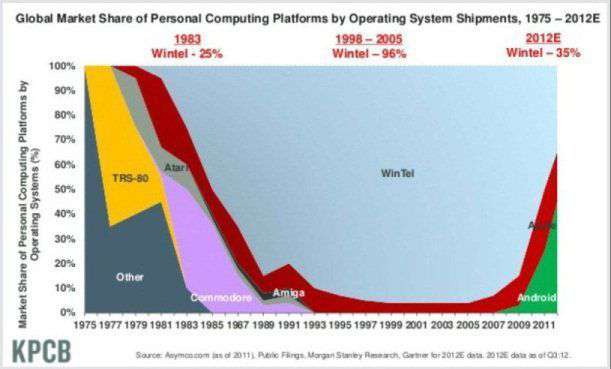It doesn’t take a particularly clear crystal ball to know that Mobile technology is taking over from more traditional communications. Some interesting statistics:
- There are as many mobile phones as people in South Africa
- 26% of the Mobile handsets are smartphones
- Mobile operating systems (smartphones & tablets) already have 65% of the operating system market, vs. Windows at just 35%.

These are the devices that your clients will be using to connect with you – with your business. These numbers take Mobile out of the “interesting, but peripheral to my business” and make your Mobile strategy very important. Mobile is a big discussion, partly because there is so much that can be done through this channel, but also because of the array of technical decisions that need to be made.
Here are five strategic areas that KRS believes every business should consider.
1. Functionality – walk before you run:
Deciding what functionality you would like to offer is key. As a smartphone user, you’ve seen the myriad of applications that use built-in cameras or GPS, like Instagram or Waze. You’ve seen the rise and rise of smart social connectivity: old favourites Facebook and Twitter joined by new apps like Pinterest and WikiVoyage.
But remember that text messaging is still the biggest mobile communication channel, and you don’t have to start off high-tech to reach your market (US statistics tell us the average American teenager sends over 3,400 text messages a month).
Useful services can be built using just interactive text messages. Imagine a shopper texting “whereis XXX” to find a product in a store, when there isn’t a sales assistant in sight? Or checking their account balance, or even authorizing a debit order payment? These are all low-tech, low-cost services that will put your business ahead of the competition.
Moving up a notch, you should complement your company’s web site with a targeted mobile version. First-generation .mobi sites often looked clunky and were awkward to use, but the steady evolution of mobile browsers and smart JavaScript software allows today’s sites to detect, and seamlessly adapt to, just about any smartphone.
Also look inwards, to the needs of the organization itself: put your most used internal business functions onto a mobile web site for your sales force.
Or web-based daily dashboards, displaying critical business information for your top executives on their smart phones? Take what you already have, and maximize your IT investment by delivering the same information to your mobile platform. KRS has some practical technical tips for you to do just this if you’d like to chat to us further.
Finally, think about bleeding edge innovation, but only once you are already comfortable with all the lessons of mobile platforms. Some ambitious mobile ideas will fail, but hopefully a step-wise strategy will help avoid these costly lessons.
2. Building for the Future – mobile is here to stay:
Your first mobile app is often done as a stand-alone application, using an R&D approach. The next step is to define a technology strategy, so that your IT department isn’t lumbered with a slew of stand-alone applications all built with different technologies. It’s sobering how fast leading edge can become legacy. Legacy, in this sense, is best defined as any implemented application that is difficult to support or enhance!
These cool new applications aren’t just the flavour of the month — they are your mobile portal for the future. A good architect or technology partner will help define a consistent framework for your mobile applications.
A clear architectural vision will ensure that the new mobile applications are easy to support and enhance, and allow you to respond quickly to new market challenges. Good early building blocks will help your team raise productivity when it really matters.
3. Development Methodology – the need for speed:
Your first decision is to decide which Mobile platforms you will support. Each platform requires different development tools and user interface formatting. Apple and Android are the market leaders, with Blackberry and Windows lagging a little behind.
There are now over 500 third-party software tools, addressing every need (real and imaginary) of the mobile application life-cycle. There are the expected programming languages and development tools, some of which claim to seamlessly support all mobile platforms. Sadly, the promise of “write once, run everywhere” is rarely fulfilled.
Beyond the nuts and bolts of writing software, there are also Software Development Kits to handle advertising services; user analytics; software monitoring and error reporting; cross-promotion networks; social media interactions and voice services. There are also dozens of Cloud services on offer: content distribution networks; storage as a service; database as a service; platform as a service and infrastructure as a service. An experienced development partner, with a commitment to the business needs of the client, can go a long way towards cutting through this thicket.
Speed of development is a big advantage. Waze, the social traffic and navigation app that launched in 2009, reached 30 million users in 2012. That’s a lot of growth, and they did so well because they were innovating ahead of the competition. Your Mobile strategy needs to include up-skilling your development team to meet the business pressure to deliver fast and often.
4. Scale – bigger is better:
“Millions of users” sounds like a dream for any business, but it could be a nightmare for your technical department. We have all experienced booking servers falling over under peak loads, and it is a sure fire way to chase away clients — sometimes for ever.
We’ve already touched on Cloud services, which can offer instant scalability to web applications designed to spread the load across many servers in parallel. But, once one has worked through the complex pricing models, Cloud services can become prohibitively expensive for anything larger than a modest start-up.
Some interesting alternatives are hosting your own server at an ISP if it’s connectivity that you need, or looking at Open Source projects like PostgreSQL or one of the new NoSQL databases if you need large data capacity without prohibitive licencing costs.
The technologies may be new, but scalability draws on traditional Software Engineering skills and experience. Decide which parts of the application need to scale, and in what magnitudes, and then build your strategy accordingly.
5. The final strategy element – it’s all in the detail:
The successful Mobile strategy will have the big picture elements well expressed, but will also drill down to the detail of testing and implementation. This is the non-sexy end of the strategy, but encompasses the most important critical factors for successful implementations.
There is a fascinating, if cautionary, case study from the last USA Presidential elections, where the Republican Party’s Mobile strategy failed on voting day. Voting officers couldn’t access the servers, and the process of calling voters and getting them to the voting stations was severely compromised. The software was fine, but the discipline of getting the implementation details right hadn’t been followed.
Mobile is a large topic, and testing the software, the servers, connectivity and display across multiple devices is the lifeblood of a professional implementation.
Call Steve Randles at KRS if you’d like to hear how we can assist your business in the game-changing move to Mobile.


